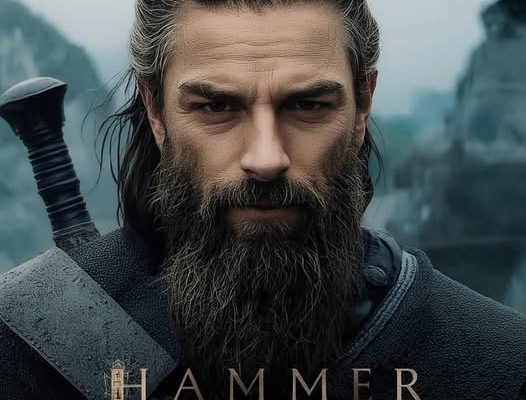The winds howl across a bleak, storm‑torn coastline, and the shards of ice‑cold spray mirror the crimson spatter that coats the battlefields of legend. In this ruthless landscape emerges Hammer of the Gods, a brutal new Viking saga that tears through myth and mercy alike. Released on Netflix, this film delivers one of the bloodiest, most savage stories of the Norse age — and it doesn’t pull a single punch. What begins as a mission to retrieve a lost brother quickly spirals into a reckoning with destiny, power and the iron‑fisted rule of violence in a world gone mad with war.
Set in Viking Britain in the year 871 AD, Hammer of the Gods opens with a dying king, his domain under threat, and a young prince thrust into the cold exigencies of fate. The father’s dying words send his son, Steinar, across hostile terrain to find his older brother — banished, embittered, and the one hope the clan has left to stave off annihilation. Wikipedia+3Movie Insider+3Protagonist Pictures+3 From the moment Steinar takes his first step on the quest, the atmosphere is suffused with dread, violence and the unavoidably brutal logic of Viking survival. The film makes no pretense of gentleness — a fact plainly stated in the promotional materials: “a world whose only language is violence.” Movie Insider+1
The visceral imagery begins early. From axes and sword‑blades slicing through shielded limbs to the implacable advance of a torrent of bloodied warriors, Hammer of the Gods sets its tone without compromise. Critics and audience alike have noted the relentless depiction of brutality: dismemberment, throat‑cutting, savage duels, even betrayal and dark psychological violence appear throughout. Some have criticized the film’s gore as gratuitous; others have praised it for not shying away from the horror of its setting. On review aggregator sites, the film holds a low critics’ score but a loyal niche of fans who relish its raw, unfiltered vision. Rotten Tomatoes+2IMDb+2
Yet beneath the carnage lies a dark and brooding narrative about leadership, loyalty, brotherhood and the cost of power. Steinar’s journey is not simply physical but symbolic: he must stride into the maelstrom, confront his brother, confront his own doubts, and emerge as the ruler his father desires — cold, uncompromising, and prepared to wield the hammer of judgment. Protagonist Pictures The banished brother, meanwhile, becomes a reflection of what Steinar might become if he gives in to rage, bitterness or despair. The clash between them is the heart of the story, and the film builds to that moment with thunderous inevitability.
The setting, too, contributes to the crushing weight of the tale. Britain, 871 AD, a land worn by war, treachery, shifting loyalties and the creeping tentacles of new faiths and powers. The Viking clans are not merely raiders here but soldiers of a dying kind of honour, pressed from all sides, and forced to decide if they will submit or fight. Wikipedia The film uses the moor, the forest, the pit of darkness into which warriors are hurled, the mist‑shrouded traps — all serve to underscore that this is no romanticised legend of golden‑haired heroes, but a grim experience of rage, blood and survival.
What lifts Hammer of the Gods above many less ambitious films is that it recognizes the horror inherent in its backdrop and leans into it. The characters are hardened. They bleed. They suffer. There is no easy resolution, no immaculate redemption. The father’s demands, the brother’s banishment, the betrayals both internal and external — these frame a world in which mercy is a luxury and the hammer that falls is heavy indeed. The screenplay permits moments of reflection, but only enough to set up the next thunderous confrontation, not to soften the edges.
Production‑wise, the director Farren Blackburn (on his feature debut) and writer Matthew Read pull no punches. The fight choreography is raw, ungroomed, often brutal in its pace, and the cinematography leans into the bleakness of the environment. The result is not the high‑gloss Viking epic of blockbuster studios; rather it is a grittier, almost underground vision of Norse vengeance. Protagonist Pictures+1 Some reviewers may critique its budget or polish, but in many ways those limitations enhance the authenticity of the carnage. The grit becomes texture, the rawness a feature rather than a flaw.
It is worth noting that Hammer of the Gods may not be for everyone. Viewers searching for a light Viking adventure, or a mythic romance of warriors and honour, may find its tone punishing. Some reviewers have pointed to its excessive gore, thin character arcs, or uneven pacing. One site described it as “trying too hard” to shock. Sarah G. Vincent Views But for those who crave the visceral, the merciless, the unvarnished age of the axe and shield, this film offers exactly that.
Thematically, the film taps into something ancient and persistent: the idea that in a world of chaos, leadership demands ruthless clarity. The father King Bagsecg, dying and desperate, issues one final command: find your brother, and bring the clan’s hope back. Wikipedia Steinar must answer that call, and in so doing face not just external enemies, but the internal ones: fear, ambition, failure, doubt. His brother Hakan, estranged and bitter, stands in for what happens when power is denied, when exile shapes heart and mind into something dangerous. The interplay between exile and ambition, between the call to duty and the desire for vengeance, becomes the engine of the story.
Violence becomes not spectacle alone but something the characters internalize. The battles are not choreographed dances — they are chaotic, brutal, exhausting. Pain and death are ever‑present. The camera lingers on the weight of what it takes to rule in such times. Hammer of the Gods refuses to sugar‑coat the cycle of violence: heroes bleed, support fails, hope ebbs, and yet the onward march continues. The rising storm is mirrored in the characters’ hearts.
From a cultural perspective, Hammer of the Gods taps into the continuing fascination with Viking mythology, the clash of Norse and Christian worlds, and the transformation of tribal structures into the modern age of states and faiths. In the film’s backdrop, negotiations, betrayals, shifting allegiances between Saxons and Norse reflect the instability of the era. While the film isn’t a documentary‑style account of the Viking age, its setting evokes the broader struggle: honour versus survival, tradition versus change. The banishment of the elder brother becomes metaphorical — exile not just from home, but from identity, loyalty, self.
On streaming platforms like Netflix the film finds a new audience — people craving gritty medieval stories, violent convictions, and warrior ethos without sugar‑coating. The convenience of streaming juxtaposed with the film’s uncompromising content makes for a potent mix: you can press play at home, but you’re not spared. You’re thrust into that cold, rain‑soaked forest, you hear the axe swing, you watch the body fall, you feel the weight of survival. The intimacy of streaming amplifies the brutal immediacy of the tale.
One of the strongest sequences occurs when Steinar and his companions enter into contact with hooded, mysterious men who kill Grim and capture others, revealing a treachery tied to faith, politics and desperation. Wikipedia+1 This is not simply Viking clans fighting Saxons; this is a collision of worlds in which the code of war is shifting. The film uses these moments to deepen the darkness: betrayal cuts through clan, brotherhood collapses, trust becomes rare. The brother who was to unite becomes an adversary. The father’s dying command becomes a crucible.
Visually, Hammer of the Gods leans into weighted aesthetic: fog‑shrouded moors, rain‑soaked shields, the flash of sword steel under grey skies. The soundtrack underscores the tension, the weight of each blow, each step into darkness. The film’s production values may not match the budget of the biggest epics, but the atmosphere is dense, and the visuals deliver a powerful sense of place. The landscape becomes a character itself: hostile, unforgiving, indifferent to the lives that traverse it.
In terms of acting, the cast delivers with commitment despite the limitations. The lead actor, Charlie Bewley, as Steinar, gives a performance that aligns with the film’s tone — he is young, conflicted, hardened by circumstance. Cast members such as James Cosmo as the dying king provide gravitas. Movie Insider Some reviewers argued performances were uneven or that accents and characterisations did not always land; yet within the frame of this story the actors commit to the vision, and that gives the film a visceral edge. The weight of each confrontation, each decision, is borne by those on screen and perceived by the viewer.
Yet it is precisely the film’s merciless tone that engenders debate. Some critics pointed out that, while the violence is abundant, the emotional or thematic payoff at times felt shallow. One reviewer remarked that the film “could work, and I would be interested in seeing what kind of adventures… but as a standalone movie it is disappointing and a waste of time.” Sarah G. Vincent Views What this reveals is the tension inherent in such a film: when the gore becomes spectacle without meaningful exploration, there is a risk of hollow echo. But for those who appreciate the rawness and the aesthetic of warrior survival, Hammer of the Gods answers the call.
From the vantage of the Viking genre, this film occupies a distinct space. It is not the sweeping epic of thousands of warriors, grand mythology and gods walking among men. Rather it focuses on a handful of characters, their burden, their choices, and the blood‑smoke that trails them. The title itself — Hammer of the Gods — suggests a mythic weight, the instrument by which divine judgment might fall. In the film, that hammer is in the hands of men: Steinar, his brother, their father, their enemies. The gods may loom, but the human will is the active force.
For viewers — especially those in regions where Netflix streaming has brought international cinema into accessible reach — Hammer of the Gods offers a chance to experience a tale of ancient violence and redemption (if redemption can be claimed) in the comfort of home. If one engages with it expecting a polished mainstream epic, they may lean back in their seat and find the rough edges jarring. But if one prepares for a savage journey, for a tale where the battle never ends until the last man falls or the last throne is claimed, then the film hits its mark.
In many ways, the film asks: what price is leadership? What toll does exile exact? What happens when the younger generation must inherit a poisoned legacy? Steinar’s path, from obedience to vengeance to acceptance of rule, maps the arduous terrain of power in a harsh world. His brother Hakan’s betrayal and bitterness stand as the cautionary mirror. Their clash is inevitable; the throne, the clan, the bloodline — all converge upon that moment. The film’s final act pays this out with the kind of catharsis that is violent, raw, and characteristic of the age.
Ultimately, Hammer of the Gods is not for those who shy from savagery, gore or unrelenting conflict. But for those enthralled by the idea of a Viking age stripped of veneer — stripped of the Hollywood polish and reduced to steel, bone and will — it resonates. A dying king’s command, a young man’s quest, a brother’s exile, a clan’s fate: all collide in a gale of crimson ambition. The hammer falls. The gods watch. And the Vikings answer the call.
In sum, if you are looking for a film on Netflix that dares to unleash the bloodiest saga yet, that embraces the cold certainty of violence, the weight of exile and the echo of blades in the misty dawn, then Hammer of the Gods may just be the brutal ride you crave. Prepare for the storm, steel yourself, and let the hammer swing.



